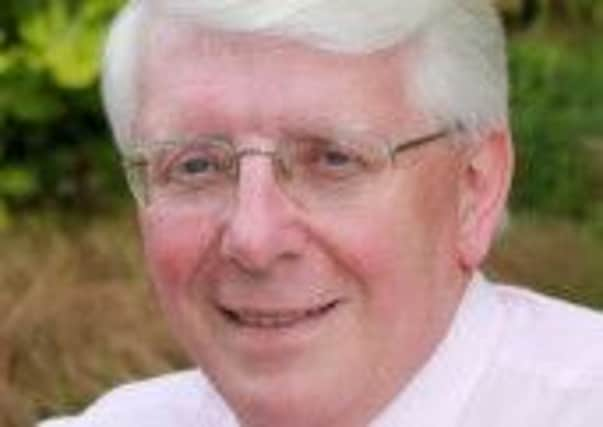Obituary: Dr George Stockdill, doctor


George was the only child of May and Arthur Stockdill. He was brought up in Holytown and attended the local primary school, where he was Dux. His secondary schooling was at Glasgow High School, a boys’ school with competitive entry for gifted individuals. This resulted in considerable sacrifice by his parents as pupils from outside Glasgow had to meet the full costs. He left school at 16 to study medicine at Glasgow University, and gained his medical degree in 1969.
George spent his early formative clinical years in Glasgow Royal Infirmary in medicine with an interest in respiratory medicine. He gained his membership of the Royal College of Physicians in 1972 and was promoted to registrar.
Advertisement
Hide AdAdvertisement
Hide AdAn expanding family made George look at his career options and to everyone’s surprise he left hospital medicine and joined a GP practice in Motherwell. After three years he decided to return to hospital and was appointed as a registrar in haematology at Glasgow Royal.
Then a senior registrar post came up in Edinburgh. He felt things were not going particularly well in the interview after a well known Edinburgh physician asked him if he had ever been to Edinburgh. George replied once – to the Tattoo. Everyone burst out laughing and George got the post at the Western General.
Although George had done some research in Glasgow this aspect flourished in Edinburgh. George was part of a group who found prognostic marker subgroups in beta-cell chronic lymphocytic leukaemia. These were defined by specific chromosomal abnormalities.
This work was published in the New England Journal. His research in Edinburgh produced more than 20 publications and included improvements in the local GP usage of the laboratory.
George obtained his membership of the Royal College of Pathologists and was then appointed as a consultant at the Western General. After five years he realised he was spending an increasing amount of time at meetings and less time with patients so in 1986 he moved to be a single-handed consultant in the Borders.
George welcomed this new challenge. His first year was at Peel Hospital before the transfer to the Borders General for a haematology post. George set up the new laboratory and created both an inpatient and outpatient clinical service. As a single hander George did everything. However, he found it very enjoyable, with an abundance of patient contact. After some time he was appointed as postgraduate tutor, a post he held for six years.
George’s expertise was sought outside the Borders and he became secretary of the Scottish Haematologist group and was appointed to the Scottish Affairs Committee of the Royal College of Pathologists, becoming secretary for three years. At Borders General he became the clinical director for medicine for several years and assistant medical director for cancer.
Having set up a chemotherapy service for his own patients he was asked to consider providing a similar service for oncology patients, mainly with breast and bowel cancer. This he did and it worked well, saving many patients the tiring journey to and from Edinburgh. George was then asked to advise the Chief Medical Officer on the provision of cancer services in rural areas and he became a member of the Scottish Cancer group at the Scottish Office.
Advertisement
Hide AdAdvertisement
Hide AdGeorge loved his work as a doctor, with patient contact providing the greatest buzz. He was an outstanding doctor who was a superb clinician with an amazing breadth of knowledge. This knowledge encompassed many other specialties. George was a charismatic character who demonstrated leadership in his many medical roles. The care of his patients was always his first concern and this led on occasions to going into hospital between courses on Christmas Day. He was honest, trustworthy and acted with integrity. During his illustrious career he received fellowships from both his Royal Colleges. George met his own illness – prostate cancer – with fortitude, dealing positively with many difficult situations and only in the last few weeks being prevented from following his many interests.
George had a huge range of interests. He enjoyed football, following the fortunes of Hearts, and loved fishing, which he found to be an effective way to relax. Workload limited this activity, however. Painting was a great interest and George studied drawing and painting in extramural classes at Glasgow School of Art, in Edinburgh and Galashiels. He always painted in watercolours, pastel and acrylic and exhibited his work in Glasgow, Edinburgh, Galashiels and Hawick. Some of his paintings are on display in the Borders General.
George loved the railings day when he was a street trader in Glasgow West End at the Botanic Gardens. George took inspiration for his painting principally from the ever-changing atmospheric conditions found in the Western Isles and the west coast of Scotland.
George masterminded in 2009 an Advent painting for Holy Trinity Church in Melrose. Sixteen members of the congregation produced a segment of a painting of the Annunciation by the Chinese artist He Qi.
George loved outdoor activities – his garden, walking locally, the west coast of Scotland and the Lake District. Travel was enjoyed mainly in Europe. Cruising was an increasing interest and the thrill of seeing new places and meeting new people were greatly enjoyed.
George loved life. He had a great sense of humour and loved story telling. He read widely, was well informed and kept up to date with world affairs.
George was a truly unique person and he will be missed. He is survived by his wife Elizabeth, daughters Helen, Frances and Lesley, and his eight grandchildren.